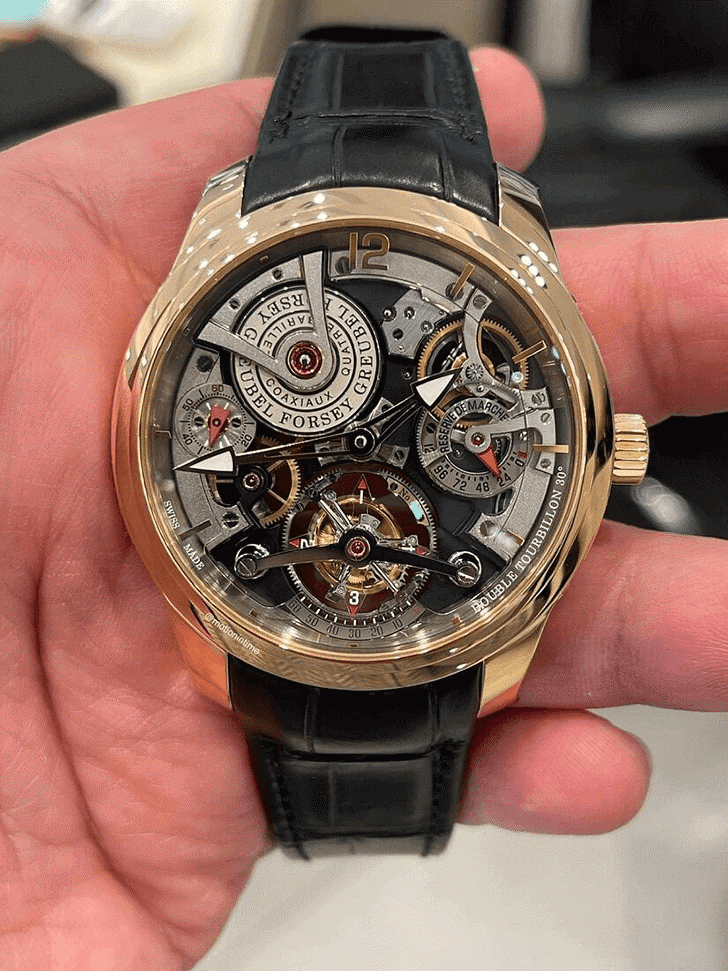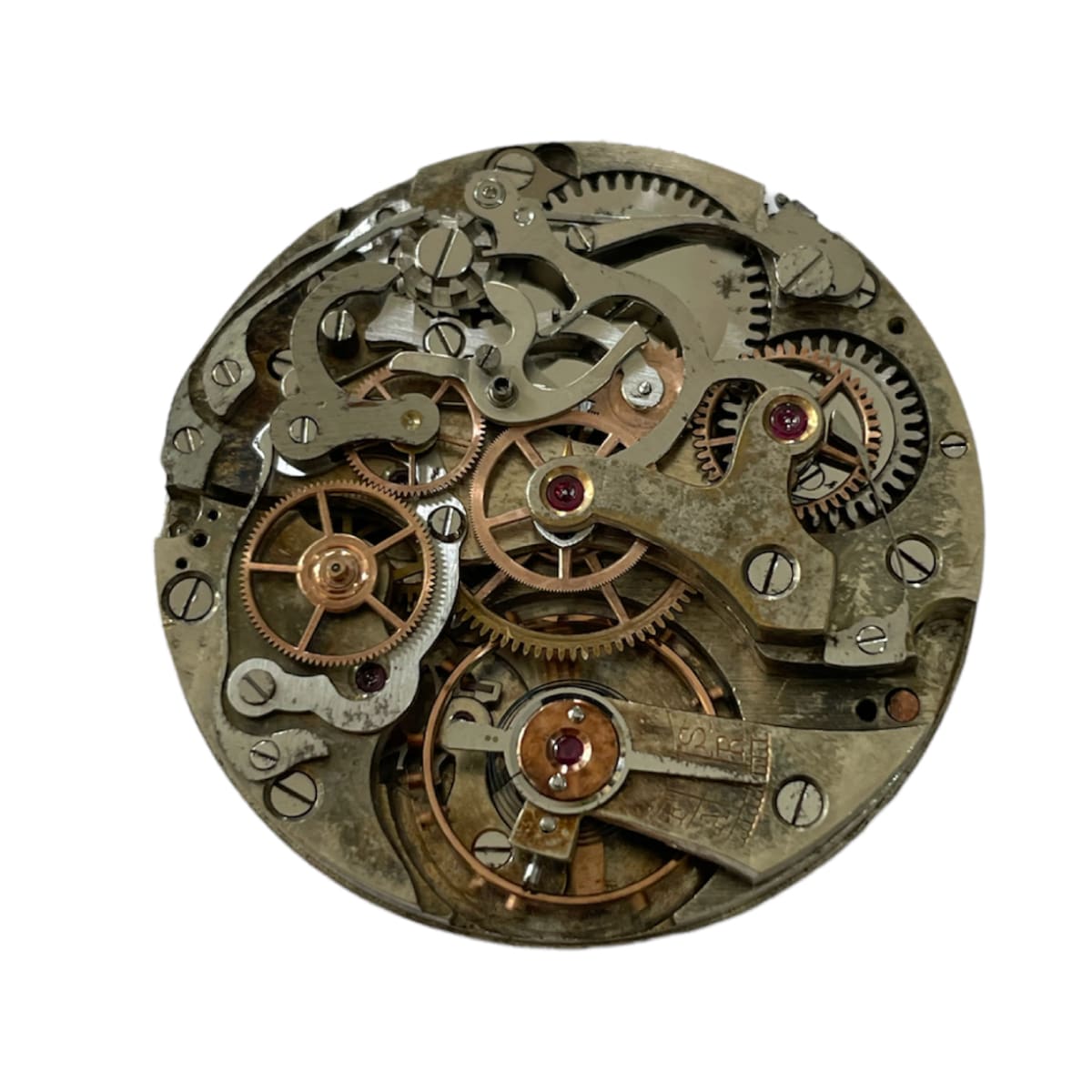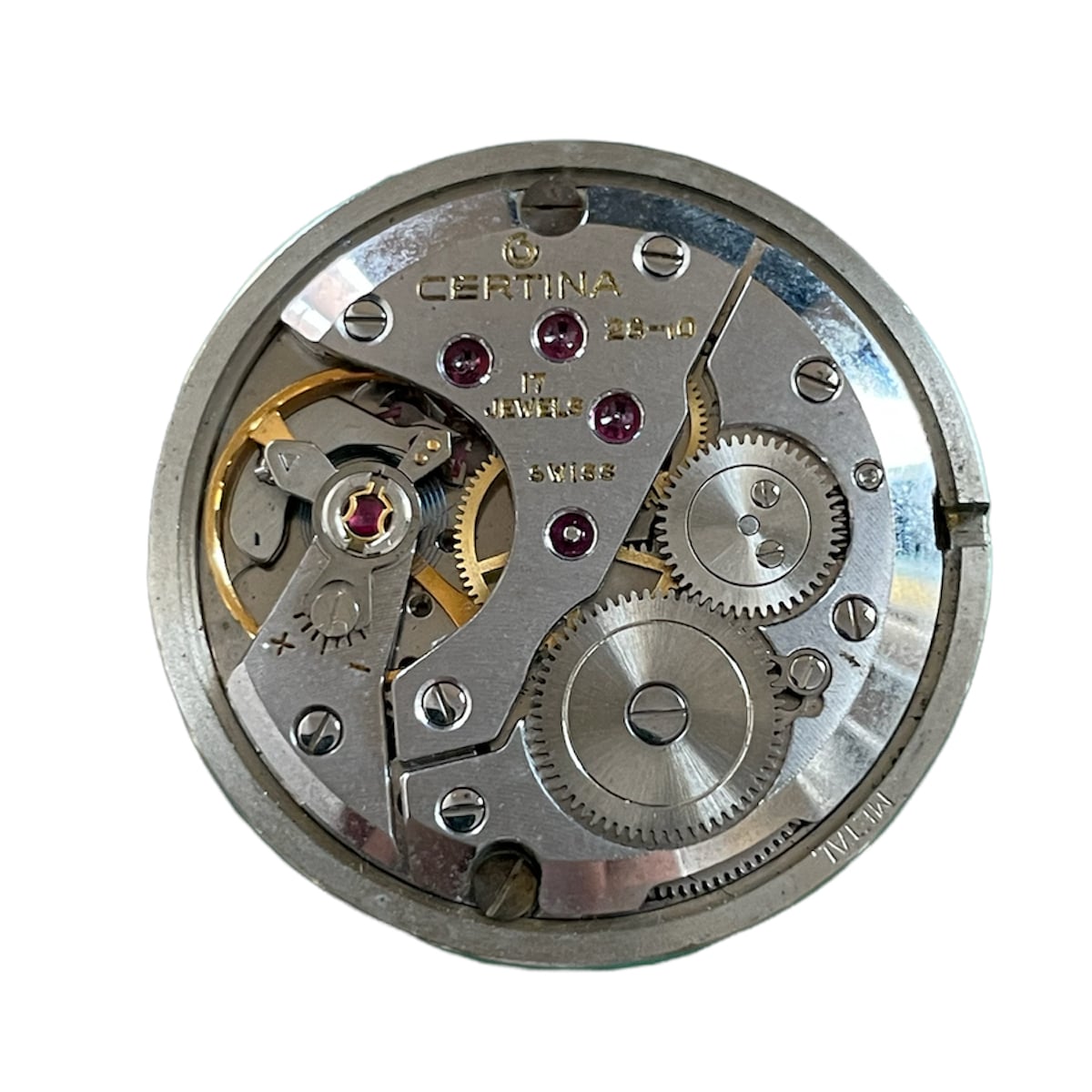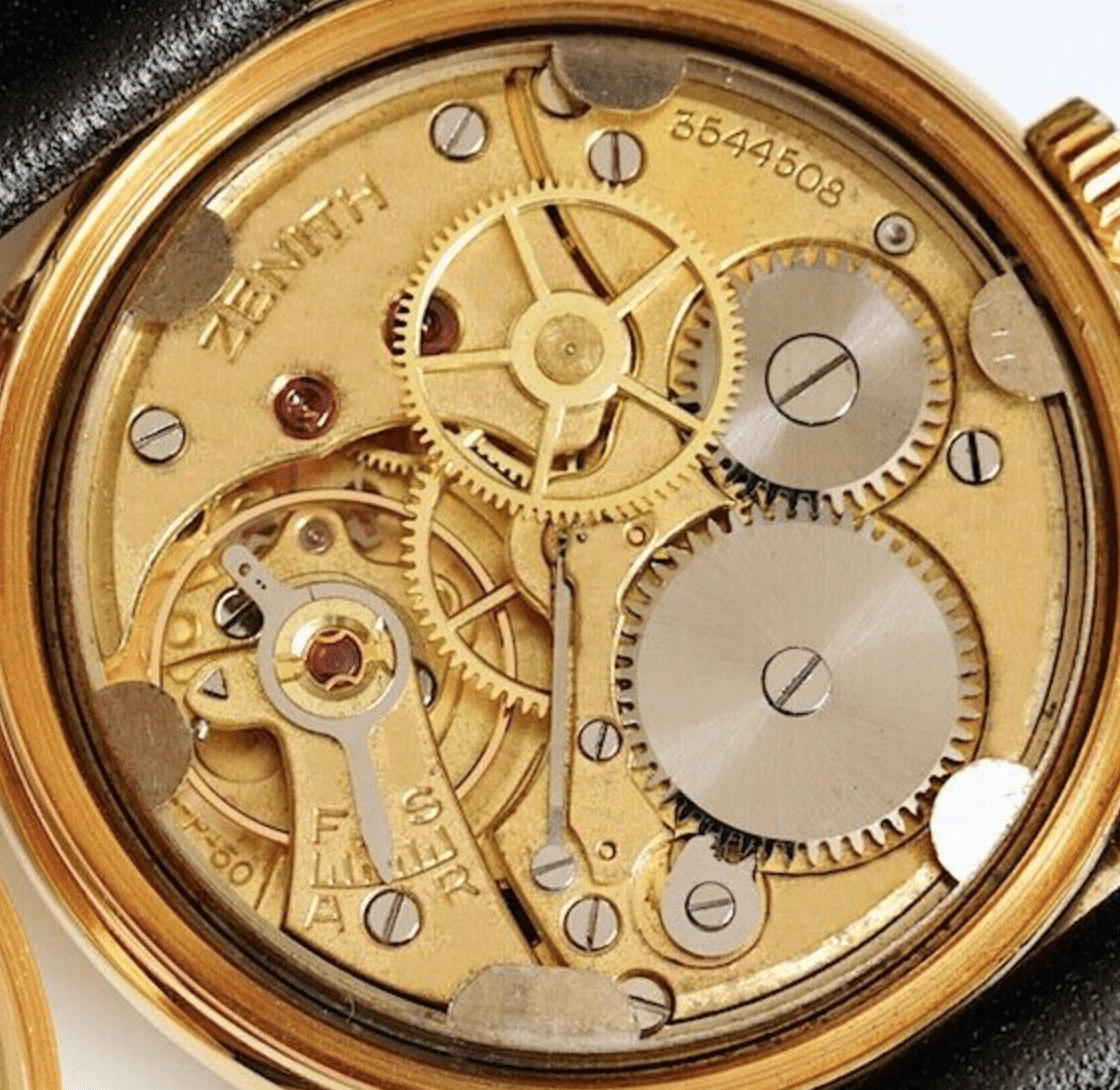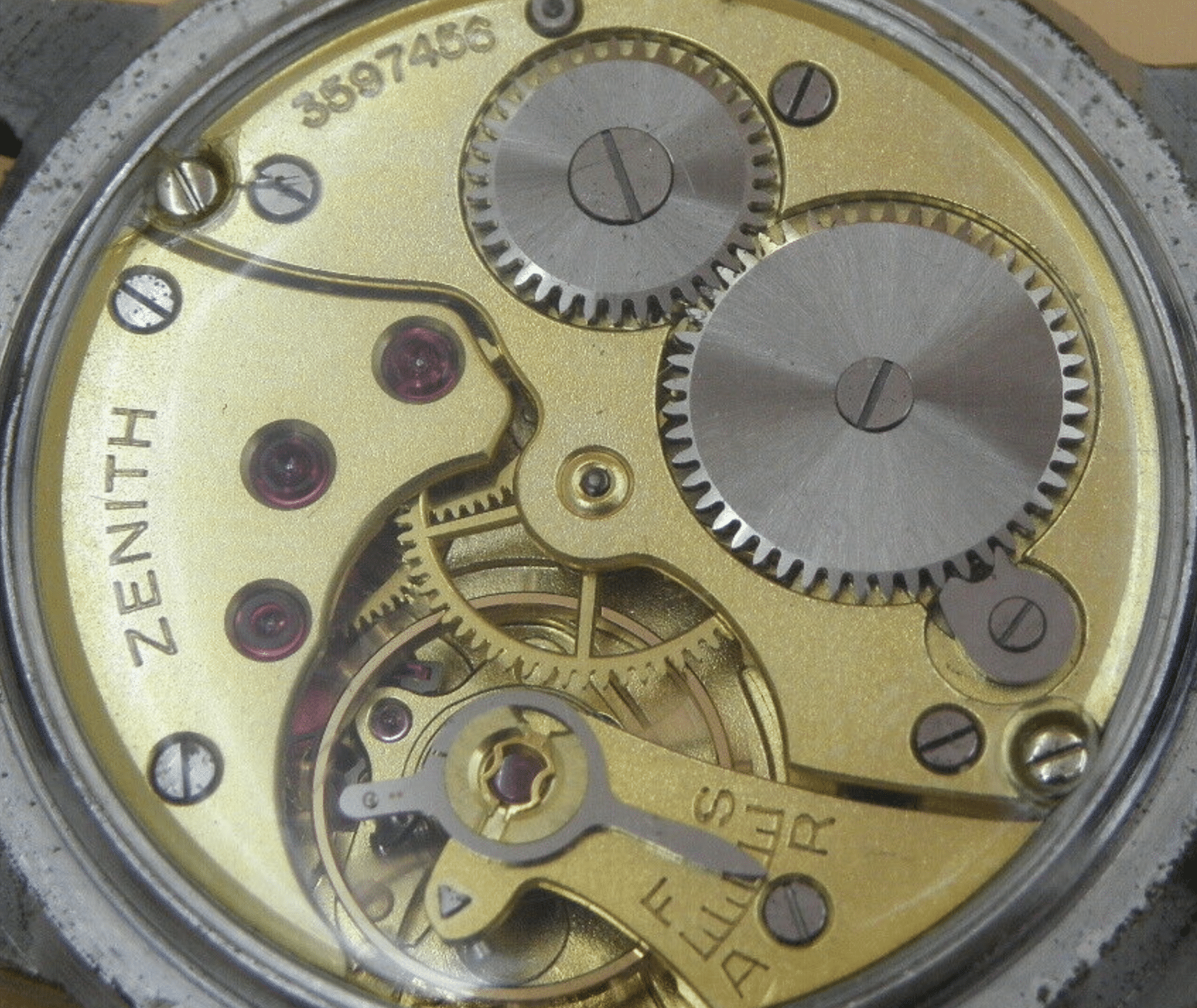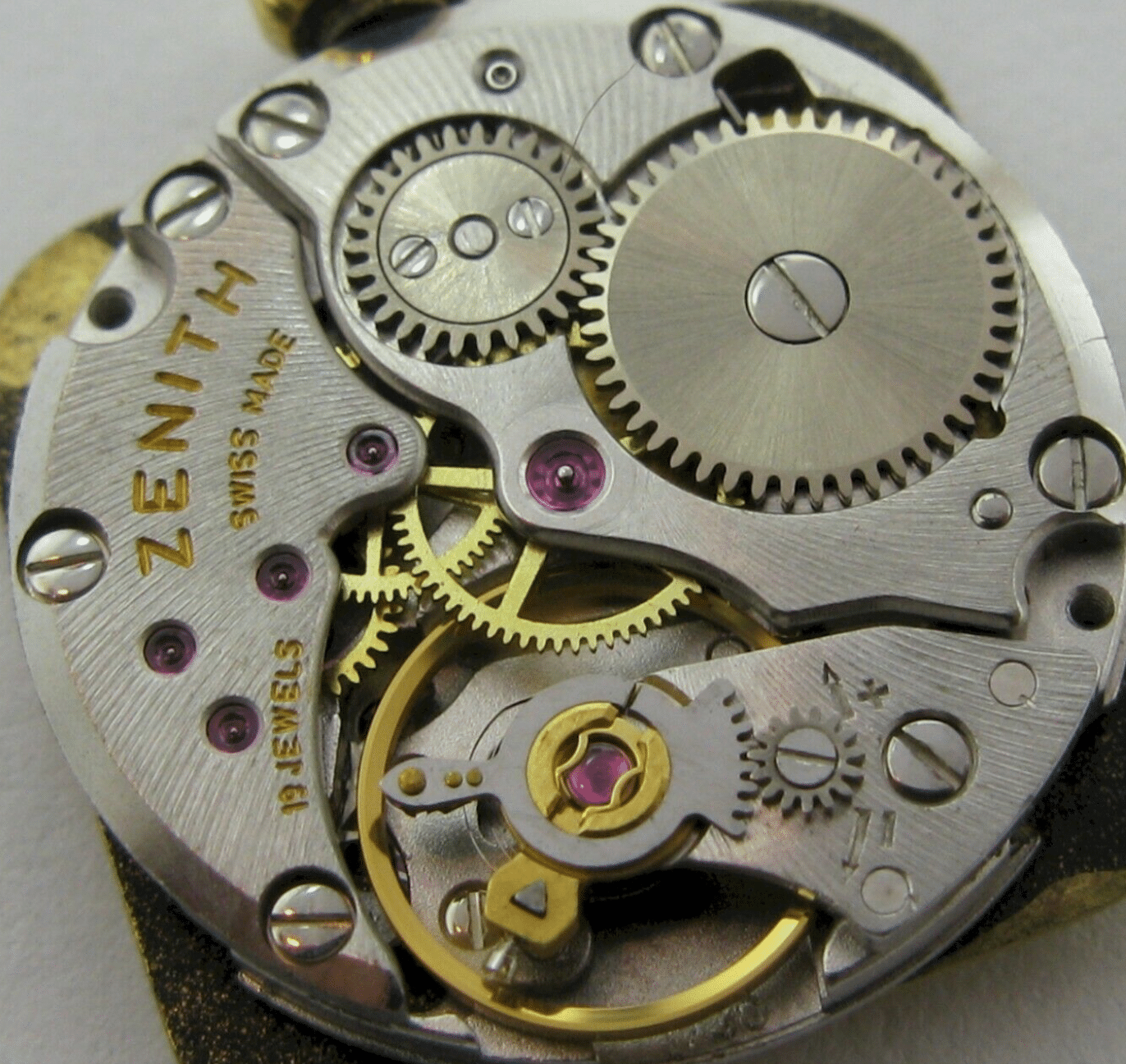Addendum -The portion of a tooth of a wheel or pinionbeyond the pitch circle.
Arbor – Axis of the balance wheel or mainspring barrel.
Balance – The vibrating wheel of a watch, which,in conjunction with the balance spring, regulates the progress of the hands.
Balance arc – A part of the vibration of a balance.
Balance cock – The support for the upper pivot of the balance staff.
Balance spring – A long fine spring that regulates the vibration of the balance.
Balance staff – The axis of the balance.
Banking pins – Two pins that limit the angular motion of the lever.
Banking to the drop – An adjustment of the banking pins permitting the escape wheel teeth to drop off the pallets.
Barrel – A circular box for the reception of the mainspring.
Barrel arbor. The axis of the barrel, round which the main-spring coils.
Beat – One vibration of the balance and spriiig.
Berylliumalloy – An alloy of iron, nickel, and a small percentage of beryllium, used for balance and balance spring.
Breguet spring – A balance spring in which the outer coil is raised above and carried over the body of the spring.
Bridge – Upper plates in a watch for the support of the wheels.
Butting – Two wheels touching on the points of the teeth when entering into action with each other.
Cannon pinion – The pinion with a long pipe to which the minute hand is fixed.
Center of gravity – That point in a body around which the mass is evenly balanced.
Center wheel – The wheel in a watch the axis of which usually carries the minute hand.
Chronograph – A watch that has a center-seconds hand driven from the fourth wheel which can be started, stopped, and caused to fly back to zero by pressing on a knob or lever.
Chronometer – A boxed timepiece for use on ships at sea.
Chronometer escapement – A spring detent escapement used in chronometers. Invented by Pierre LeRoy about 1765.
Circular escapement – An escapement so constructed that the central portion of each pallet stone’s impulse face stands at an equal distance from the pallet center.
Circular pitch – The pitch circle divided into as many spaces as there are teeth on the wheel or pinion.
Club-tooth wheel – That type of wheel which has a lifting face off the end of the teeth.
Clutch pinion – The pinion surrounding the square of the stem. Serves alternately to wind and set the watch.
Collet – A small, circular piece fitting friction-tight to the balance staff and which is pierced to receive the inner coil of the balance spring.
Compensating balance – A balance the rim of which is made of brass and steel. The diameter is caused to increase or decrease in different temperatures, so as to compensate for changes in temperature on both balance and spring.
Corner safety test – A test to show the presence or absence of safety lock when the slot corner is brought in contact with the roller jewel.
Crescent – A circular notch in the edge of the roller table for the reception of the guard pin or finger.
Crown – A grooved circular piece fastened to the stem for winding the watch.
Crown wheel – A wheel that drives the ratchet wheel.
Curb pins – Regulator pins.
Curve test – A test used to discover if the curves of the lever horns are correctly related to the roller jewel.
Cylinder escapement – A frictional escapement patented by Thomas Tompion 1695.
Dedendum – The portion of the tooth of either wheel or pinion inside of the pitch circle.
Dial train – A train of two wheels and two pinions that control the progress of the minute hand and the hour hand.
Diametrical pitch – The diameter of the pitch circle divided into as many spaces as there are teeth on a wheel or pinion.
Discharging pallet – The pallet stone which an escape wheel tooth slides over in order to emerge from between the pallet stones.
Distance of centers – The distance on a straight line from center to center, as between balance center and pallet center.
Double-roller escapement – A form of lever escapement in which a separate roller is used for the safety action.
Draw – A force that keeps the lever against the banking pins,created by the slant of the pallet stones.
Driven – The mobile that is being forced along by the driver.
Driver – The mobile that forces the other along.
Drop – The free motion of the escape wheel after impulse to the pallets has been given.
Drop lock – The extent of the lock on the pallets after an escapement has been banked to the drop.
Duplex escapement – A watch escapement in which the escape wheel has two sets of teeth. One set locks the wheel by pressing on the balance staff. The other set gives impulse to the balance. The balance receives impulse at every other vibration. Accredited to Pierre LeRoy about 1750.
Epicycloid – A curve generated by a point in the circum-ference of a circle as it rolls upon another circle. It forms the kind of tooth used in watch wheels.
Equidistant escapement – An escapement so constructed that the locking faces of the pallet stones stand at an equaldistance from the pallet center.
Elinvar – A nonrusting, nonmagnetizing alloy containing iron, nickel, chromium, tungsten, silicon and carbon. Used for balance and balance spring.
Fourth wheel – The wheel of a watch that drives the escape pinion.
Guard pin or finger – A pin or finger working in and out of the crescent to preserve the safety action.
Guard safety test – A test to show the presence or absence of safety lock when the guard pin or finger is brought in contact with the edge of roller.
Heel of tooth – Letting-oif corner of a tooth of the escape wheel.
Horns – The circular sides of the fork leading into the slot.
Hour wheel – The wheel that carries the hour hand.
H3rpocycloid – A curve generated by a point in the circum-ference of a circle when it is rolled within another circle.
Impulse pin – Roller jewel.
Invar – A steel alloy containing about 36 per cent nickel. Used in the making of balance wheels.
Isochronism – The property of a balance spring that allows it to perform the long and short arcs in equal time.
Letting-off comer – Corner of a pallet stone from which a tooth lets off.
Lever – A metal piece attached to the pallets that carries impulse to the balance.
Lever escapement – A watch escapement that delivers impulse to the balance by means of two pallet stones and a lever.
The extremity of the lever has a forked slot that acts directly on a roller jewel which is attached to the balance. Invented about 1750 by Thomas Mudge.
Lift – The pitch or slant of a tooth or pallet stone.
Line of centers – A line drawn from center to center, as of any wheel or pinion.
Locking – The overlapping of a tooth on a pallet stone.
Lossier curves – The theoretical outer and inner terminals as designed by L, Lossier.
Main train – The toothed wheels in a watch that connect the barrel with the escapement.
Middle-temperature error – The temperature error between the extremes of heat and cold characteristic of a compensating balance and steel balance spring.
Minute wheel – The wheel driven by the cannon pinion.
Out of angle – Unequal angular motion of the lever from the line of centers when an escapement is banked to the drop.
Overbanked – A term used to indicate that the lever escapement is out of action.
Overcoil – The last coil of the Breguet spring that is bent up and over the body of the spring.
Pallet arms – The metal body which contains the pallet stones.
Pallets – The metal body attached to or a part of the lever. The term includes the pallet arms and pallet stones.
Pallet staff – The axis of the pallets.
Pallet stones – Jewels or stones inserted in the pallet arms.
Phillips spring – A balance spring with terminal curves formed on lines laid down by M. Phillips.
The term “Phillips’ curve” is rarely used.
Pinion – The smaller wheel with teeth called leaves, working in connection with a larger wheel.
Pitch circle – A circle concentric with the circumference of a toothed wheel and cutting it’s teeth at such a distance from their points as to touch the corresponding circle of a pinion working with
it and having with that circle a common velocity, as in a rolling contact.
Pitch diameter – The diameter of the pitch circle.
Pivot – The end of a rotating arbor.
Plate – Discs of brass or nickel which form the foundation of a movement. The lower plate lies next to the dial. The upper pieces supporting one, two, or three wheels are generally referred to as bridges.
In the full-plate watch the upper piece is called the top plate.
Potence – A hang-down bracket used for supporting the lower pivot of the balance staff in full-plate watches.
Quarter screws – Four screws used in timing.
Ratchet wheel – A wheel that is fastened to the barrel arbor.
Ratchet tooth wheel – The name given to the English type escape wheel which has pointed teeth.
Receiving pallet – The pallet stone over which a tooth of the escape wheel slides in order to enter between the pallet stones.
Remaining lock – The lock remaining when the guard and corner tests are tried. More often called “safety lock.”
Repeater – A watch that strikes, having two hammers and two gongs. A lever Is provided to set the striking mechanism into action. A quarter repeater strikes the hour and the last quarter hour.
A minute repeater, in addition, strikes the number of minutes since the last quarter.
Right-angled escapement – An escapement in which the Hne of centers of the escape wheel and pallets are at right angles to pallets and balance.
Roller jewel – A long, thin jewel inserted in the roller table; sometimes called impulse pin.
Roller table – A circular disc attached to the balance staff in which is fitted the roller jewel.
Run of lever – The motion of the lever toward the banking pins when slide is present. Run always equals slide
Safety lock – The lock remaining when the guard and corner tests are tried.
Semitangental escapement – An escapement where the locking face of the receiving pallet is planted 31 degrees from the line of centers and the discharging pallet 29 degrees from the line of centers. The receiving pallet locks only on
the tangent.
Shake – The space separating the letting-off comer of the pallet from the heel of a tooth when the opposite pallet is locked at the lowest locking corner.
Shake is always less than drop.
Single roller escapement – A form of lever escapement in which one roller performs the functions of both impulse and safety actions.
Slide – The opening of the banking pins beyond that of drop lock.
Steady pins – Pins used to secure the perfect alignment of two pieces of metal.
Stem – The winding arbor of a watch.
Stop work – A mechanical device for preventing the over winding of a mainspring.
Straight line escapement – An escapement in which the centers of the escape wheel, pallets, and balance are planted in a straight line.
Stud – A small piece of metal pierced to receive the outer coil of the balance spring.
Third wheel – The wheel of a watch that drives the fourth pinion.
Timing screws – Screws used to bring a watch to time, sometimes called the mean-time screws.
Toe of tooth – Locking corner of a tooth of the escape wheel.
Total lock – Drop lock with slide added.
Train – A combination of two or more wheels and pinions, geared together and transmitting power from one part of a mechanism to another.
Tripping – A tooth of the escape wheel running past the locking face of a pallet stone at a time when safety lock should be present.
Wheel – Any circular piece of metal on the periphery of which teeth may be cut of various forms and numbers.
Winding pinions – A pinion surrounding the stem that drives the crown wheel.
